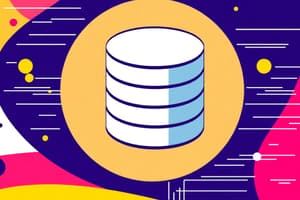Podcast
Questions and Answers
What was one of the primary limitations of using traditional information storage methods before the advent of databases?
What was one of the primary limitations of using traditional information storage methods before the advent of databases?
- Difficulty in searching and retrieving (correct)
- Ease of data retrieval
- Ability to handle large data volumes
- High security standards
Which database model was introduced in the 1970s as a standard tool for database design?
Which database model was introduced in the 1970s as a standard tool for database design?
- NoSQL Model
- Entity-Relationship Model (correct)
- Hierarchical Model
- Relational Database Model
In which decade did SQL become the standard language for database management?
In which decade did SQL become the standard language for database management?
- 1960s
- 1980s (correct)
- 1970s
- 1990s
What term describes databases designed to manage unstructured data such as images and text?
What term describes databases designed to manage unstructured data such as images and text?
Which of the following developments occurred in the 2000s regarding database technology?
Which of the following developments occurred in the 2000s regarding database technology?
What is a DataLake primarily used for?
What is a DataLake primarily used for?
Why do many databases start as lists in spreadsheets or word processing programs?
Why do many databases start as lists in spreadsheets or word processing programs?
What aspect is NOT a basic function of a database?
What aspect is NOT a basic function of a database?
What is the primary function of a Database Management System (DBMS)?
What is the primary function of a Database Management System (DBMS)?
Which of the following best describes the conceptual design in DBMS architecture?
Which of the following best describes the conceptual design in DBMS architecture?
Which capability is NOT typically provided by a DBMS?
Which capability is NOT typically provided by a DBMS?
How does a DBMS ensure data integrity?
How does a DBMS ensure data integrity?
Which of the following features relates to performance optimization in a DBMS?
Which of the following features relates to performance optimization in a DBMS?
What best describes the physical level in a DBMS?
What best describes the physical level in a DBMS?
Which statement is true about DBM Tools and Software?
Which statement is true about DBM Tools and Software?
Which SQL operation would you use to remove a record from a database?
Which SQL operation would you use to remove a record from a database?
Flashcards
Database
Database
A collection of interrelated data organized for easy access, management, and updates. It consists of tables with rows and columns, and relationships between them.
SQL (Structured Query Language)
SQL (Structured Query Language)
The standard language for communicating with databases. It allows users to retrieve, insert, update, and delete data.
NoSQL Database
NoSQL Database
A type of database that manages non-structured data such as images, text, and audio. It handles data without a fixed format.
Data Mining
Data Mining
Signup and view all the flashcards
Data Warehouse
Data Warehouse
Signup and view all the flashcards
Data Lake
Data Lake
Signup and view all the flashcards
Big Data Database
Big Data Database
Signup and view all the flashcards
Cloud Databases
Cloud Databases
Signup and view all the flashcards
What is a DBMS?
What is a DBMS?
Signup and view all the flashcards
What is meant by 'Storage' in a DBMS?
What is meant by 'Storage' in a DBMS?
Signup and view all the flashcards
What is 'Retrieval' in a DBMS?
What is 'Retrieval' in a DBMS?
Signup and view all the flashcards
What are 'Manipulation' functions in a DBMS?
What are 'Manipulation' functions in a DBMS?
Signup and view all the flashcards
What is the role of 'Integrity' in a DBMS?
What is the role of 'Integrity' in a DBMS?
Signup and view all the flashcards
What is the purpose of 'Security' in a DBMS?
What is the purpose of 'Security' in a DBMS?
Signup and view all the flashcards
Why are 'Back up and Recovery' important in a DBMS?
Why are 'Back up and Recovery' important in a DBMS?
Signup and view all the flashcards
What are 'Performance Optimization' techniques used in a DBMS?
What are 'Performance Optimization' techniques used in a DBMS?
Signup and view all the flashcards
Study Notes
Introduction to Databases
- Databases are essential for managing data in today's digital world, facilitating efficient data management across various industries
- Examples of industries include e-commerce platforms, social media networks, banking, healthcare, education, logistics, supply chain management, customer relationship management (CRM), and government services
Before Databases
- Traditional methods for storing and managing information included paper, magnetic tapes, books, accounting records, and electronic files/directories
- These methods had limitations in searching, retrieving data, lacking integrity and security, and were unable to handle large data volumes
Evolution of Databases
-
1970s: The Entity-Relationship (ER) model emerged as a standard tool for database design.
-
Introduction of the first Relational Database Management Systems (RDBMS).
-
Oracle was a key early RDBMS innovator
-
1980s: IBM developed SQL, which became a standard language for interacting with databases.
-
RDBMSs like Sybase and Microsoft SQL Server gained popularity.
-
1990s: NoSQL databases and data mining gained prominence.
-
NoSQL databases became prominent in the management of unstructured data (images, text, audio), along with data warehousing and data mining
-
2000s: Open-source databases like MySQL, PostgreSQL, and Neo4j became more common.
-
The use of cloud-based databases and Big Data became important for large-scale data management
Basic Concepts of Databases
- Databases organize interrelated data into tables containing rows and columns.
- Tables represent relationships between data elements, such as people, products, and orders.
- Databases' role as a comprehensive method for storing various kinds of information needs to organized, managed effectively, and updated.
Database Management Systems (DBMS)
-
DBMS (Database Management System) software manages, defines, queries, updates, and administers databases.
-
DBMS software acts as an intermediary between users and databases
-
DBMS software allows for secure, efficient storage and retrieval of data, ensuring data integrity and security
-
Tools and software provide interfaces to interact with and manipulate data, allowing for querying, updating, and reporting.
-
Typical operations include data storage in structured formats, retrieval through query languages (like SQL), and manipulation (insertion, updating, deletion) of data.
Importance of Databases in Financial Analysis
- Databases provide a structured way to store and manage data related to markets, transactions, and financial records, to enable easy access.
- Databases enable organized data for analysis, reporting, and prediction.
- Databases improve informed decision making and assist in identifying trends and forecasting.
- Effective database systems ensure accuracy and confidentiality of sensitive financial data.
3 Architecture Levels of Databases
- Conceptual Design: Defines entities (e.g., customers, products) and relationships between them without technology details.
- Logical Design: Describes databases in more detail in terms of tables, columns and how entities and their attributes relate to each other. Not constrained by specific technology.
- Physical Design: Specifies actual data storage structures, access methods, and other implementation-level details relevant to the specific database system that will be used. This level is dependent on the chosen database management system (DBMS).
Studying That Suits You
Use AI to generate personalized quizzes and flashcards to suit your learning preferences.




